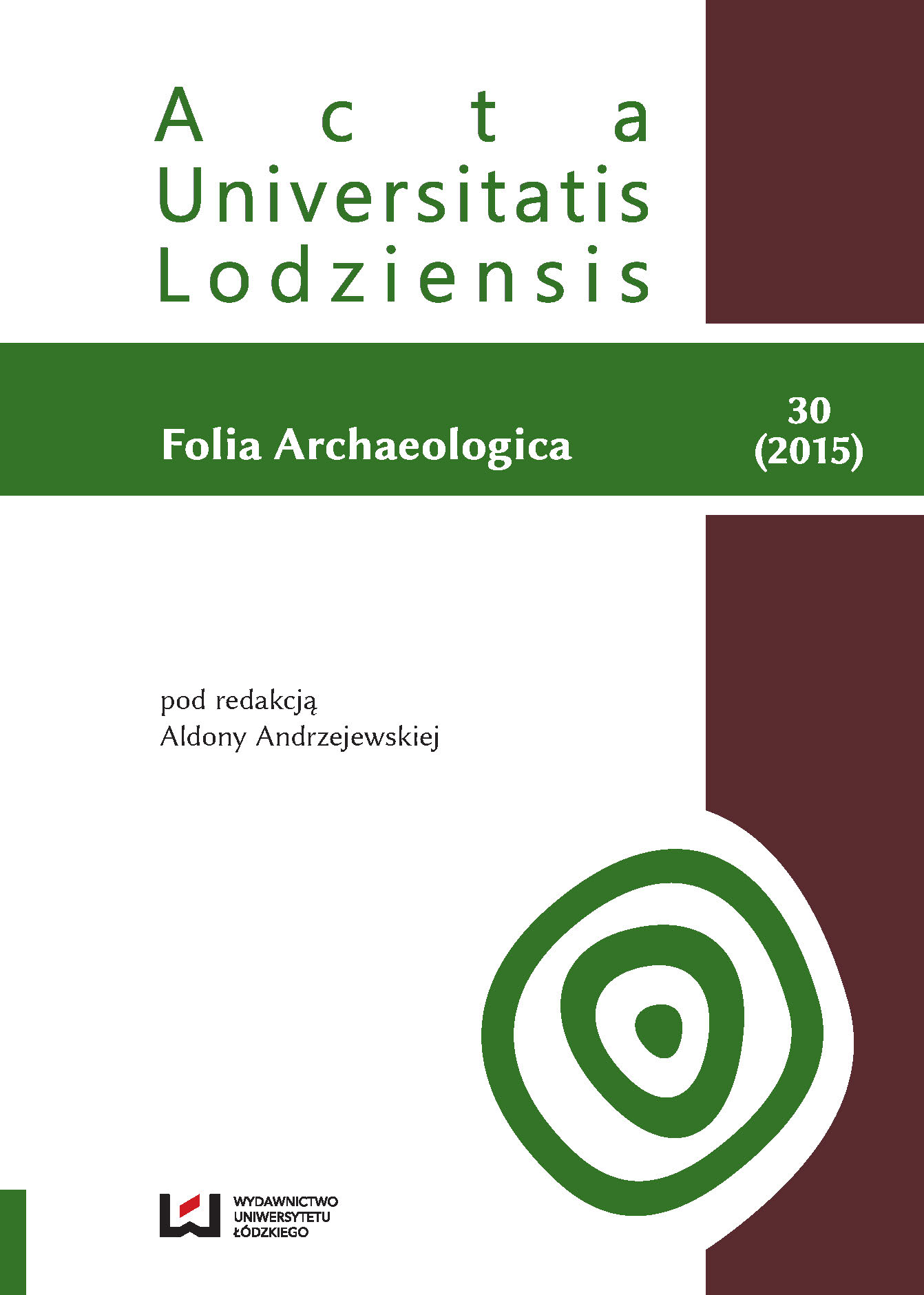Doryforos w pancerzu – czyli o wizerunku Augusta z Prima Porta słów kilka
DOI:
https://doi.org/10.18778/0208-6034.30.06Słowa kluczowe:
Cesarstwo Rzymskie, posąg Augusta, zbroja cesarzaAbstrakt
Images of emperors of Julio-Claudian dynasty and especially the most famous representation of Octavian Augustus of Prima Porta, became the prototype representation of emperors-officers for the representatives of the next dynasty wielding Roman Empire. Statue of Augustus, no doubt modeled on Doryphoros – a statue made by Polykleitos (sculptor-foundry of classical Greek era) is an example of the propaganda image of the emperor. Statua loricata – a statue of Octavian in the breastplate – presents emperor during adlocutio – speech addressed to the army. Models of classical Greek sculpture exhibit at the statue of the emperor by using position called contrapposto and deification of the emperor by showing him barefoot. Among other things, lack of shoes indicates that the statue of Octavian was made after the death of the ruler. The divine pedigree of the emperor was also marked by the attributes that are on his right leg – Cupid and dolphin. Head of Augustus was also performed on the model Doryphoros, and its distinctive hairstyle is defined as a „Primaporta” type. The most important element of the Prima Porta statue of the emperor is his breastplate. Armor classified as a torso cuirass is here as long type – with the downward extension, meant to protect the lower abdominal part. Armor probably originally made of leather, on the statue of Octavian is very richly decorated with historical and mythological reliefs. In the central part of the armor was shown a scene that shows the Parthians transferring military signs (signum militare) that have been lost by Marcus Crassus in 53 BC. On both sides of middle scene, were placed two women – personifications of lands conquered by Rome. The whole presentation is observed by the images of deities: Tellus Mater – Mother of Earth, Apollo, Diana, the god of the Sun – Sol, goddess of the moon – Luna and the God of heaven – Caelus.
Statue of Augustus from Prima Porta combines classical designs of sculptures of Polykleitos period and contemporary elements of the propaganda of the imperial policy of the Augustus principate. Sculpture showing the first emperor of the Roman Empire, dressed in breastplate has become an example image of the rulers shown as the leaders of the army but also showing the immense power of propaganda policy.
Pobrania
Bibliografia
Flawiusz J., Wojna żydowska, tłum. J. Rodożycki, Rytm, Warszawa 2007.
Google Scholar
Florus L. A., Zarys dziejów rzymskich, tłum. I. Lewandowski, Ossolineum, De Agostini Polska, Wrocław, Warszawa 2006.
Google Scholar
Horacy F. K., Dzieła wszystkie, T. I, Ody i Epody, wyd. O. Jurewicz, Ossolineum, Wrocław 1986.
Google Scholar
Pliniusz S. C., K. Pliniusza Starszego Historyi naturalnej ksiąg XXXVII. T. 1, tłum. J. Łukaszewicz, Księgarnia i Drukarnia J. Łukaszewicza, Poznań 1845.
Google Scholar
Swetoniusz T. C., Żywoty Cezarów, tłum. J. Niemirska-Pliszczyńska, Ossolineum, Wrocław 1987.
Google Scholar
Encyklopedia (1974), Encyklopedia sztuki starożytnej: Europa, Azja, Afryka, red. K. Michałowski, Wydawnictwo Artystyczne i Filmowe, Warszawa.
Google Scholar
Furtwängler A. (1895), Masterpieces of Greek Sculpture. A series of essays on the history of art, W. Heinemann, London.
Google Scholar
Hölscher T. (2011), Sztuka rzymska: język obrazowy jako system semantyczny, (tłum. Polskie) L. Olszewski, Wydawnictwo Poznańskie, Poznań.
Google Scholar
Kopaliński W. (1990), Słownik symboli, Wiedza Powszechna, Warszawa.
Google Scholar
Krawczuk A. (1978), Cesarz August, wyd. 3, Ossolineum, Wrocław.
Google Scholar
Makowiecka E. (2007), Sztuka grecka, wyd. 2, Wydawnictwa Uniwersytetu Warszawskiego, Warszawa.
Google Scholar
Makowiecka E. (2010), Sztuka Rzymu: od Augusta do Konstantyna, Wydawnictwa Uniwersytetu Warszawskiego, Warszawa.
Google Scholar
Michałowski K. (1970), Jak Grecy tworzyli sztukę, Wiedza Powszechna, Warszawa.
Google Scholar
Parandowski J. (1960), Mitologia. Wierzenia i podania Greków i Rzymian, wyd. 9, Czytelnik, Warszawa.
Google Scholar
Rose Ch. B. (1997), Dynastic Commemoration and Imperial Portraiture in the Julio-Claudian Period, Cambridge Studies in Classical Art and Iconography, Cambridge.
Google Scholar
Sadurska A. (1980), Archeologia starożytnego Rzymu, T. 2, Okres cesarstwa, PWN, Warszawa.
Google Scholar
Seaby H.A. (1978), Roman Silver Coins. Volume I. The Republic to Augustus, Seaby Publications Ltd., London.
Google Scholar
Słownik (1958), Słownik grecko-polski, red. Z. Abramowiczówna, PWN, Warszawa.
Google Scholar
Spring P. (2005), Guide to the Vatican. Museums and City, Vatican Press, Vaticano.
Google Scholar
Sumner G., D’Amato R. (2009), Arms and Armour of the Imperial Roman Soldier: From Marius to Commodus, 112 BC–AD 192, Frontline Books, London.
Google Scholar
Zanker P. (1973), Studien zu den Augustus – Porträts. I, Der Actium – Typus, Abhandlungen der Akademie der Wissenschaften in Göttingen. Philologisch-Historische, Klasse, F. 3, nr 85, Vandenhoeck & Rupert, Göttingen.
Google Scholar
Zanker P. (1999), August i potęga obrazów (Augustus und die Macht der Bilder), tłum. L. Olszewski, Wydawnictwo Naukowe UAM, Poznań.
Google Scholar
Żygulski Z. jun. (1998), Broń starożytna. Grecja, Rzym, Galia, Germania, Krajowa Agencja Wydawnicza, Warszawa.
Google Scholar
Pobrania
Opublikowane
Jak cytować
Numer
Dział
Licencja

Utwór dostępny jest na licencji Creative Commons Uznanie autorstwa – Użycie niekomercyjne – Bez utworów zależnych 4.0 Międzynarodowe.












